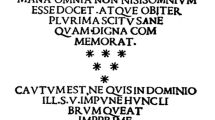Abstract
Diophant was the classical Greek author who was the last to become known in Christian Europe. Figures who passed on Diophant's writings decisively were Regiomontan, Scheubel, Ramus, Joachim Camerarius the elder, and the Wittenberg mathematicians Praetorius, Dieterich and Schuler. The first Diophant edition, a translation into Latin, was published by Xylander in Basel in 1575. In the forword Xylander mentions all the details about how he managed to take possession of Dudith's mansucript. Xylander's publication is more than a mere translation since he transformed Diophant's symbolism into the common symbolism of his own age and added extensive comments. Xylanders edition was the only one existing until the one of Bachet was published in 1621.
Similar content being viewed by others
Literatur
[Allard 1985] Allard, André: “Le Manuscrit des arithmétiques de Diophante d'Alexandrie et les lettres d'André Dudith dans le Monacensis Lat.10370”.Mathemata, Festschrift für Helmuth Gericke, hrsg. von Menso Folkerts und Uta Lindgren, Stuttgart 1985, S. 297–315.
[Allard, im Druck] Allard, André: “Reflexions of the transmission stages of a Greek scientific text: the example of Diophantus”.History of science, history of text, hrsg. von Karine Chemla, Berlin 30.3–2.4.1995, im Druck.
[Curtze 1902] Curtze, Maximilian: “Der Briefwechsel Regiomontan's mit Giovanni Bianchini, Jacob von Speier und Christian Roder”.Urkunden zur Geschichte der Mathematik im Mittelalter und der Renaissance, Leipzig 1902 (Nachdruck New York, London 1968), S. 187–236.
[Folkerts 1977] Folkerts, Menso: “Regiomontanus als Mathematiker”.Centaurus 21 (1977) S. 214–245.
[Folkerts 1993] Folkerts, Menso: “Die nachgelassenen astronomischen und mathematischen Manuskripte des Johannes Praetorius (1537–1616) in Erlangen, München und Schweinfurt”.450 Jahre Copernicus “De revolutionibus”. Schweinfurt 1993, S. 29–50.
[Folkerts 1996] Folkerts, Menso: “Johannes Praetorius (1537–1616)—ein bedeutender Mathematiker und Astronom des 16. Jahrhunderts”,History of Mathematics: States of the Art (Studies in Honor of Christoph Scriba), hrsg. von Joseph Dauben, Menso Folkerts, Eberhard Knobloch und Hans Wussing, San Diego 1996, S. 149–169.
[Jayawardene 1963] Jayawardene, S.A.: “Unpublished Documents Relating to Rafael Bombelli in the Archives of Bologna”.Isis 54 (1963) S. 391–395.
[Morse 1981] Morse, Joann Stephanie:The reception of Diophantus' “Arithmetic” in the Renaissance, Ph.D. Princeton University 1981, University Microfilms International.
[Reich 1968] Reich, Karin: “Diophant, Cardano, Bombelli, Viète. Ein Vergleich ihrer Aufgaben”.Rechenpfennige (Kurt Vogel zum 80. Geburtstag gewidmet). München 1968, S. 131–150.
[Schmeidler 1972] Schmeidler, Felix (Hrsg.):Johannis Regiomontani Opera Collectanea, Regiomontans ausgewählte Schriften. Osnabrück 1972.
[Swerdlow 1993] Swerdlow, Noel M.: “Science and Humanism in the Renaissance: Regiomontanus's Oration on the Dignity and Utility of Mathematical Sciences”. Paul Horwich:World Changes. Thomas Kuhn and the Nature of Science. Cambridge/Mass., London 1993, S. 131–168.
Author information
Authors and Affiliations
Rights and permissions
About this article
Cite this article
Reich, K. Die Ręzeption Diophants im 16. Jahrhundert. NTM N.S. 11, 80–89 (2003). https://doi.org/10.1007/BF02908589
Issue Date:
DOI: https://doi.org/10.1007/BF02908589



